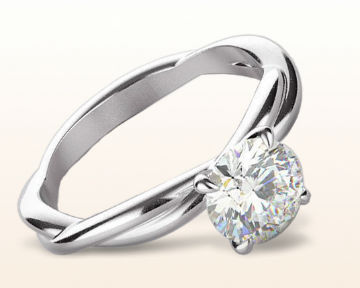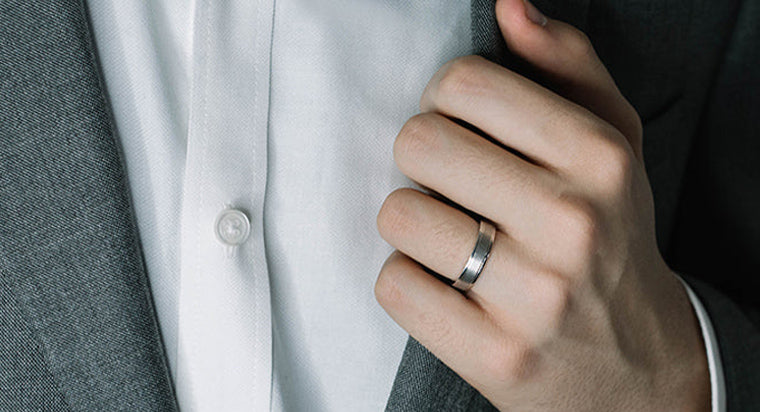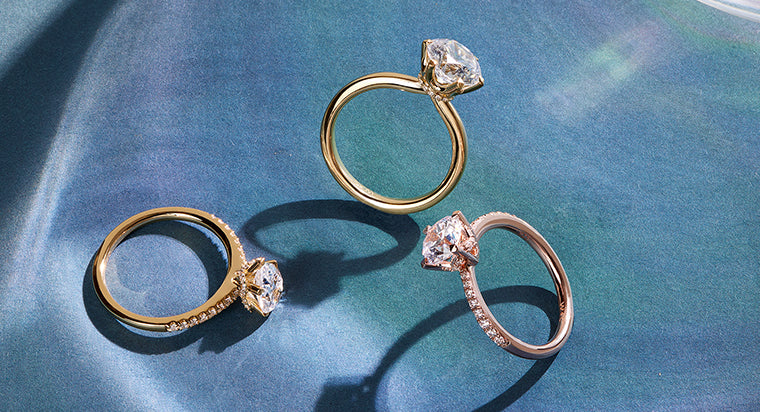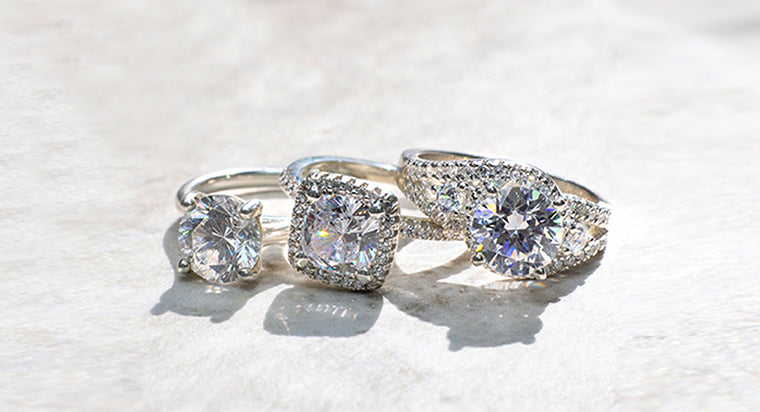White Gold vs Platinum: Which Metal Is Best For Your Ring?

Sorry, your quest for the perfect engagement ring doesn't end at the diamond or gemstone. When crafting the ring, you need to contemplate the band on which the stone is set. Ideally, the band for an engagement ring is made of either gold or platinum. The debate tends to get heated when you start talking color — they look similar, so in the white gold vs. platinum rivalry, who should win?
Although white gold and platinum look similar, sharing a silvery hue, the two are actually quite different in terms of color, durability, and price. Platinum is somewhat whiter, somewhat stronger, and definitely more expensive than white gold. Read on to find out which choice is best for your preferences and budget.
TABLE OF CONTENTS
White Gold Quality & Purity
The first step in choosing the perfect metal for your engagement ring is to know the difference between them. White gold is a popular metal for engagement rings which has more of a silver tone within the white hue.
24 karat vs 18 karat vs 14 karat White Gold:
It's made by combining gold alloy with a variety of white metals such as silver, nickel and palladium. The mixture's amount of alloy vs. gold creates the karat, or purity of the gold. Twenty-four-karat gold is considered pure, but it's also soft and easily damaged, which makes it impractical for everyday wear. This is why gold is alloyed — to make it more durable. Eighteen-karat white gold is a classic metal with a high purity level within the gold realm; it consists of 75% gold and only 25% alloys, which gives it a high value. Pieces made of 14-karat white gold tend to last longer, because they consist of 58.3% gold and 41.7% pure alloys.
14k vs 18k White Gold
The differences between 14k and 18k white gold go beyond purity, extending to durability: Because 18-karat white gold is quite soft and malleable, 14-karat white gold is often considered a better option. Although the quality of the gold may be lessened by alloys, it's much stronger, more durable and more scratch-resistant. (Durability can be improved by using a process called rhodium plating, which also improves the hue of white within the metal. More on that below.)

There's also a difference in color: Because of its higher purity, 18k white gold tends to look whiter and brighter than 14k white gold, but you rarely see engagement rings in white gold that don't have rhodium plating. The rhodium plating, which both 14k and 18k white gold engagement rings get, gives the setting that really white shine and luster that people love.
Considering Durability and your Lifestyle
We'll go into durability a little more later on, but a quick note about it here. When you're considering yellow or rose gold, there's a big difference in the durability between 14k and 18k. But that just isn't the case with white gold. You're going to notice very little difference in their strength because they're both dipped in rhodium.
Why might you choose 14k white gold vs. platinum? Again, cost. But if durability is a serious concern for you - say, you're a doctor, craftsperson or in the service industry and use your hands a lot all day — you might want to look into platinum for to see if the investment is worthwhile for you.
Platinum Quality & Purity
Platinum is a naturally white metal, which means that you don't need to combine it with other substances to get that cool tone. Almost all platinum is about 95% platinum and 5% other pure alloys, which explains the higher cost.
Its soft white hue is visually pleasing, but platinum is also renowned for its strength and durability - so much so, that platinum was taken off the market during wartime for military use. It's safe to say that platinum is a great option for individuals who want a sturdy engagement ring option.
Platinum Wins the Durability Competition
Since platinum is the most durable metal in addition to being the densest, it shouldn't be a surprise that this metal is also the most expensive. Being about 20% denser than white gold, platinum is about two-and-a-half to five times more expensive than white gold. Because it's less malleable, platinum is a more difficult material to work, so the cost of labor that goes into molding that piece increases.

Although scratches in rings or jewelry are inevitable, when platinum is scratched, the metal is not lost as it is in white gold. Rather, the color shifts within the ring itself, creating what is known as a patina finish. In some cultures this is actually seen as a beautiful thing, and a symbol for how long you and your paramour have been together. In the U.S., opinions differ from person to person, but some people embrace the platinum patina.
Benefits of White Gold and Platinum
In comparison to platinum, white gold is typically more prone to damage because of its use of alloys. However, white gold is also a much lighter metal than platinum, which can better suit people who don't desire heavy metals in their rings. White gold is also of a much lower cost than platinum, making it a more affordable option.
Hypoallergenic Rings
Another benefit of platinum is that it's hypoallergenic. Being a naturally white metal, there's no need to combine it with nickel, which can be an allergen for certain individuals. Nickel is one of the alloys required to create white gold's finish, which can be a problem for wearers whose skin is sensitive to this metal.
But if white gold is coated with a top layer of rhodium plating, it reduces and sometimes even completely eliminates the contact that exists between the nickel and one’s skin. (This plating can wear off over the years, giving the metal a yellowish tint and requiring the ring to be replated by a jeweler, which can add cost.)
White Gold vs Platinum Price
Just like there are the four C's of diamonds, there are a variety of factors to consider when it comes to choosing your engagement ring metal. Cost is one of main Cs of metals. There are two things to consider when looking at price: cost of buying and cost of care. If you're looking at sticker price, white gold is the more budget-friendly option. We generally recommend purchasing white gold so you can maximize other aspects of your engagement ring, such as the diamond.
White Gold vs Platinum Durability
Durability and cost should be considered together. Platinum is more durable and requires less repolishing. But that doesn't mean you only need to re-polish your white gold engagement ring every so often to keep it shining. White gold is finished with a rhodium plating to give it a pure white shine and improve durability. But it does wear off over time. That means you'll need to replace it.

Depending on how often and how hard it's worn, the rhodium plating could last anywhere from one to three years. Rhodium plating costs about four times as much as platinum, but "dipping" your ring, or having it replated, is relatively inexpensive. Expect to pay anywhere from $60 to $120 to have your ring dipped, depending on the complexity of the setting and style. If you need to get that done each year, the cost adds up. (Read more about ring dipping here)
Here at With Clarity, we try to save our customers that cost. That's why we offer a lifetime warranty that covers ring replating and polishing. That ensures your With Clarity ring will be beautiful for a lifetime.
White Gold vs. Platinum: Care and Cleaning
When cleaning white gold or platinum, a mix of simple soap and water is the best solution when trying to clean these metals.
- First, mix simple dishwashing soap with warm water
- Second, soak your jewelry in the solution for approximately 20 to 40 minutes depending on how dirty the piece is
- If there is some residue from a substance you wish to remove (such as lotion), use a soft toothbrush to gently brush the residue away
- Next, rinse the ring or piece of jewelry under warm water (with the plug closed!)
- Lastly, dry the ring with a nonfibrous cloth, and it should be ready to go!
*Note: if you are choosing to use a jewelry cleaner or polisher, it is important to look for any abrasive chemicals within the solution. Certain chemicals, such as chlorine, can make the ring become discolored or lose durability, ultimately damaging the piece of jewelry.
More about: White Gold Metal Care
In comparison to platinum, white gold requires more maintenance and upkeep. When gold is scratched, the gold is actually scratched away and lost, meaning gold will eventually need to be replated. Gold also requires more frequent polishing (every 6 months).
More about: Platinum Metal Care
Platinum metal requires less maintenance thang and upkeep than gold. Platinum can be cleaned regularly at home and will be kept looking shiny brand new with an annual polishing. When scratched, the metal is not actually chipped away or lost, it is simply just moved around. Other metals, such as gold, actually lose a piece of the metal when they are scratched. This means that a quick buffing and polish can move the platinum back into place. A quick go with a jewelry polishing cloth will move the platinum metal back into place.
Is Platinum Better than 14kt White Gold?
Both metals offer obvious benefits. Platinum is:
- More hypoallergenic
- More durable (requiring less repolishing)
- Is naturally white (so no plating is required)
- Is heavier (so the value is greater vs white gold)
Whereas white gold is:
- Slightly shinier
- Costs less than platinum
- Has great durability to protect stones
- Is the most popular metal choice when it comes to rings
Is platinum or white gold better for engagement rings? White gold might be the better choice for you if you're on a budget and want to maximize the other aspects of your engagement ring, like opting for a more intricate setting or a better diamond. If, however, you have a preference toward platinum, there is certainly no reason to shy away. Metal is a commodity that increases in value slowly over time. 14-karat white gold is less valuable than platinum because of lower purity. Even though the raw value of pure gold and platinum are almost equal, that's why the cost is quite different in jewelry.
So platinum isn't necessarily better than gold — it's all about your priorities.
Our Favorite Settings for Platinum & White Gold Rings
Although all of our engagement ring settings are available in platinum as well as either 14k or 18k white gold, these are some of our favorites to pair with that clean white hue. The design elements lend themselves well to this icy shine in order to make your hand-selected diamond the true star of the show.

Braided Solitaire Engagement Ring
A braided solitaire engagement ring is a great engagement ring, because of the intricate design, the ring can be made with white gold and the prongs with platinum.

Grace Solitaire Diamond Ring
The open solitaire setting can be accentuated with a platinum spiral metalwork within the modern cathedral style windows, making it a beautiful option for a diamond engagement ring.

Cathedral Weaved Solitaire Diamond Engagement Ring
The trellis that is used to complement the center diamond can be made with platinum, as platinum adds more durability to engagement rings.

Flourish Diamond Solitaire Engagement Ring
For the Flourish Diamond solitaire engagement ring, both the prongs and the setting can be made with either white metal.

Sleek Cathedral Solitaire Engagement Ring
A sleek cathedral solitaire engagement ring is great with a metal made of white gold, however, if you seek a durable ring, then platinum would be the answer.

Regal Diamond Trellis Engagement Ring
A regal diamond trellis engagement ring can be done with either white gold, or platinum and can be made to be either very expensive with the platinum, or affordable with platinum.

Traditional Pave Diamond Engagement Ring
When it comes to actually deciding on the metal for an engagement ring, the clear choice is a traditional pave diamond engagement ring made of platinum, or white gold, depending on your taste.

Twirling Solitaire Diamond Engagement Ring
For a twirling solitaire diamond engagement ring, the twirling band can be done with white gold, as it is more malleable and the prongs with platinum.

Lily Diamond Engagement Ring
The delicately shaped lily petals of this ring would be suitable for a platinum engagement ring, because of the prongs that hold the diamond. The more durable the metal the longer the ring lasts.

Poised Basket Diamond Engagement Ring
The basket holding the center diamonds can either be made with white gold or platinum.
FAQs
How to clean a white gold diamond ring?
What is rhodium dip?
Can platinum rings be resized?
How much is a platinum ring worth?









